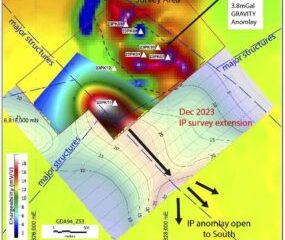Uncategorized
Emerging Markets Debt: Clearer Skies Ahead?
While we believe high inflation and monetary policy tightening have the potential to cloud the beginning of 2023, we expect market conditions to improve…


While we believe high inflation and monetary policy tightening have the potential to cloud the beginning of 2023, we expect market conditions to improve as we move through the year and inflationary pressures dissipate, particularly in the United States.
There, we believe a combination of declining food and energy prices, improving global supply-chain dynamics, a still strong U.S. dollar, and softening economic conditions should drive inflation lower. Declining inflation, in turn, should allow for a less aggressive rate-hiking cycle, leading to lower U.S. Treasury yields and reduced risk of a sharp economic contraction.
Despite a better market environment in 2023, we believe global growth is likely to be lackluster. While there is the risk of a recession in the United States, the Fed should be able to engineer a soft landing. Economic conditions could be more challenging in Europe, however, as the continent faces an unprecedented energy crisis. In China, we believe economic conditions should improve after a very weak 2022, but COVID-related measures and uncertainty in the property sector could limit the potential for a stronger economic recovery in the near term.
While we anticipate softer economic conditions in emerging markets (EMs) more broadly, we believe economic growth in these countries could come in around 3.6% in 2023 (approximately 2.5 percentage points higher than the International Monetary Fund’s [IMF’s] projected growth for advanced economies) thanks to improved economic conditions in China and still-supportive commodity prices.
Against this backdrop, let’s examine some of the factors that are shaping the opportunity set and risks in EM debt as we head into 2023.
Chinese Growth Set to Improve
Economic growth was lackluster in China in 2022 due to strict zero-COVID policies and prolonged stress in the real-estate sector, but Chinese policymakers have started to address these challenges by easing macroeconomic policies.
For example, in 2022 China lowered medium-term lending facility and prime loan rates; relaxed the floor on mortgage rates for first-time homebuyers; and encouraged state-owned banks to increase financing to property developers. It also introduced tax cuts and rebates to encourage higher consumption.
We therefore see potential for improving economic activity in 2023. However, we do not believe growth will rebound to pre-pandemic levels, because China is likely to lift its zero-COVID policy very gradually given low vaccination rates among the elderly and the potential for new strains of the virus to emerge. Challenges are also likely to remain in the Chinese property sector, given subdued housing demand and private developer debt restructuring.
Supply and Demand Dynamics Support Oil Prices
As we write this outlook, West Texas Intermediate (WTI) crude futures are trading around $75 per barrel as investors weigh the impact of tight supply against an uninspiring outlook for demand. In our view, however, the balance of demand and supply factors should support oil prices in 2023.
On the demand side, oil prices reached multiyear highs in the first half of 2022, thanks in part to the war in Ukraine, but fell in the second half of the year due to lockdowns in China and global growth concerns. While there is certainly reason to be concerned about demand growth in 2023, particularly in developed markets, we believe demand from EMs, particularly China, could rebound, supporting prices.
In our view, the balance of demand and supply factors should support oil prices in 2023.
On the supply side, several factors are likely at play. In the United States, oil-supply growth has stagnated recently, but we believe it will likely continue its general upward momentum, thanks in part to the likelihood of more releases from the strategic petroleum reserve.
Outside the United States, we do not believe we will see significant supply growth. While Russian oil seems to have found buyers, albeit at heavy discounts, the effect of sanctions on supply will be more visible in 2023. At the same time, the Organization of the Petroleum Exporting Countries Plus (OPEC+) has decided to curtail supply at higher prices and lower inventory levels than past interventions. This suggests we will see a higher floor for prices going forward.
Structural and Cyclical Forces Underpin Metal Prices
Metal prices were weaker in 2022 as the complex faced looming recession risks, sluggish demand, and U.S. dollar strength.
In most of the world, demand was subdued by macroeconomic uncertainty. In China, however, the property-market downturn and zero-COVID policies weakened demand—although some metals (such as copper) managed to offset the demand loss with demand stemming from green energy and exports.
In 2023, we expect structural and cyclical forces to underpin prices. On the structural side, continued investment in the energy transition should support demand for a number of metals, including copper, aluminum, and nickel. On the cyclical side, improved economic conditions in China and elevated market tightness should help metal prices show signs of recovery. Inventories are at multiyear lows and we believe cost pressures will remain, affecting some metals (such as aluminum and zinc) more than others.
Resilient Economic Activity Supports Fiscal and Debt Dynamics
Resilient economic activity could continue to support fiscal dynamics across EMs.
We believe the overall fiscal deficit in 2023 will be approximately –5.8% of EM gross domestic product (GDP), marginally lower than last year’s number. Basic balances (current account balances plus net foreign direct investments) should remain healthy at 1.3% of EM GDP, partly reflecting recent terms-of-trade gains enabled by higher commodity prices. Stable fiscal accounts should support debt dynamics in the next year, leading us to anticipate an overall total debt of 57% of GDP in 2023, marginally higher than in 2022.
Effective Central Bank Action Eases Inflation Concerns
The outlook for inflation varies widely across EMs. Central banks have reacted quickly to peaking inflation across Emerging Africa, Eastern Europe, and Latin America, leading to peak policy rates. Asia has been a bit further behind the curve in both inflation and central-bank policy, owing mainly to food subsidies and higher base prices from the prior year.
But broadly speaking, with central banks in many EMs preemptively hiking interest rates, real interest rates in EMs are now significantly higher than they are in advanced economies. This has supported local currencies and added to the positive fundamental landscape.
We expect global inflation to moderate significantly in coming months as the global economy slows, commodity prices moderate, and tighter monetary policy curbs demand.
Corporate Credit Fundamentals Continue Weakening
Fundamental dispersion and varying business cycles are a feature of this diverse asset class, but as we mentioned in last year’s outlook, credit quality does not improve in perpetuity—and in 2023, we believe EM corporate credit fundamentals should see a continuation of the weakening trend that emerged in the second half of 2022.
As central banks around the world raise rates to combat inflation, top lines (revenues) for nonfinancial corporates are feeling the pinch. We also expect loan growth to decelerate in most countries, with the likely exception of China.
For nonfinancial corporates, the inability to fully pass through rising costs in a weaker macroeconomic environment has led to lower earnings before interest, taxes, depreciation, and amortization (EBITDA) margins, and therefore lower cash flows.
Most EM banking systems look better positioned in terms of capital than they were during the Global Financial Crisis.
Offsetting lower near-term cash flows are years of proactive debt-profile management, which has improved interest expenses and kept maturities from becoming a broad problem. This has resulted in low default rates outside idiosyncratic situations such as Chinese real estate and Russia’s invasion of Ukraine.
For financials, lower growth, high interest rates, and high inflation pose downside risks to asset quality. However, while several large EM banking systems have certain vulnerabilities, few of them have broad challenges that would create near-term solvency and financial stability concerns. Most EM banking systems look better positioned in terms of capital than they were during the Global Financial Crisis, thanks to the implementation of robust macroprudential regulation in recent years.
Technical Conditions Should Provide Support
Technical conditions should be more supportive in 2023, in our opinion. We saw record outflows from dedicated EM debt portfolios, high market volatility, and low liquidity, which resulted in limited new-debt issuance in 2022. Forced selling by passive funds and exchange-traded funds (ETFs) created significant dislocation in the marketplace, driving prices far below their fundamental values.
While we see market conditions gradually normalizing in 2023, we anticipate another year of limited net debt issuance. Higher funding costs in primary markets should encourage issuers to tap into more affordable multilateral and bilateral financing. We also anticipate flows coming back to dedicated EM debt portfolios, attracted by appealing valuations. Reduced long-investor positioning and high investor cash levels should also add to a more constructive technical landscape.
Valuations Appear Attractive, Particularly Relative to U.S. High Yield
In our opinion, EM debt appears attractively valued on both an absolute and relative basis, with spreads wider than their historical levels. EM sovereign high-yield spreads appear particularly compelling, especially relative to U.S. high-yield levels, the chart below shows. In the distressed credit space, we believe current prices overestimate the probability of credit events and underestimate potential restructuring and recovery values.

Similarly, in the local currency universe, currency valuations remain attractive despite the broad outperformance of EM currencies versus those of developed countries in 2022.[1]
The dollar itself has backed off its peak reached in the third quarter of 2022, but still appears stretched on a longer-term trade-weighted basis. While we do not expect a significantly weaker dollar while the Fed is still in tightening mode, we see some scope for modest EM currency appreciation and a reduction in volatility as risk appetite improves.
Coupled with high nominal and real interest rates (and the latter rising further as inflation falls), we expect currencies to remain well supported by a resumption of inflows into the asset class.
All things considered, we continue to believe that current valuations overcompensate investors for credit, currency, and local rate risk, as well as volatility.
On the local rates side, there is considerable variation in attractiveness vis-á-vis our estimates of excess term premium embedded in local curves. Those markets that hiked early and often (mainly in Latin America but also more recently in Eastern Europe) have seen better support from bondholders with some curves already inverting in anticipation of policy loosening in the second half of the year. We expect curves in Asia to face some additional upwards pressure, at least in the very near term.
All things considered, we continue to believe that current valuations overcompensate investors for credit, currency, and local rate risk, as well as volatility—so EM debt may offer attractive value to investors with a medium- to long-term horizon and a willingness to tolerate a period of higher volatility.

Development Partners Help Meet Financing Needs
We believe development partners will continue to provide critical support to EMs, helping frontier markets meet their short- to medium-term external financing needs against the backdrop of challenging market conditions.
The IMF and World Bank have shown a strong commitment to meeting the external financing needs of frontier markets through both existing and new tools, such as the Food Shock Window (FSW) and Resilience and Sustainability Trust (RST). And the World Bank is considering the creation of new tools to support countries in reduction of new emissions.
Lastly, bilateral donors are providing further pivotal financing. Members of the Gulf Cooperation Council (GCC), for instance, have provided more than $12 billion in financing to Egypt with further financing to follow.
Downside Risks Remain
Although we are constructive on the asset class into 2023, we acknowledge that there are several downside risks to our optimistic outlook.
We believe current U.S. interest-rate hikes are necessary to dampen inflation and prevent embedded second-round effects in the labor market. However, as the Fed continues with monetary tightening, there is a risk that overshooting rates results in a policy mistake that could potentially engineer a U.S. recession.
Geopolitical tensions are also likely to continue to weigh on investor sentiment. The conflict in Ukraine remains unresolved, with significant risks of escalation. The outlook for Chinese growth appears challenging (as long as China continues to pursue its zero-COVID policy). And tensions between China and Taiwan pose an ongoing headwind to sentiment in Asia.
While it seems easy to point to incidents that could further disrupt market sentiment, it is important to remember that there are always potential disruptors, and the risks are already well known and perhaps even fully priced in by the markets.
Opportunities in Hard- and Local-Currency Debt
We believe EM hard-currency debt could perform well in 2023. We favor high-yield issuers over high-grade issuers, and remain strategically overweight in higher-yielding frontier markets, where we believe investors are overcompensated for credit risk and volatility.
We continue to see scope for fundamental differentiation among countries. We prefer commodity-exporting countries, especially in the energy space, but remain cautious about countries with strong trade and financial links to Russia. We also remain cautious about countries that depend on food and energy imports and countries with negative political dynamics that create institutional risks. We also prefer countries with easier access to financing, especially those that have strong relationships with multilateral and bilateral lenders.
We continue to see opportunities in select distressed debt positions, where we believe bond prices do not reflect realistic assumptions for default risk and recovery values.
Given near-term growth concerns and intermittent primary markets, we are focusing on issuers with low refinancing needs and robust balance sheets.
We also see selective opportunities in EM corporate credit, where we believe a combination of differentiated fundamental drivers, favorable supply technical conditions, and attractive absolute valuations could continue to provide ample investment opportunities.
Given near-term growth concerns and intermittent primary markets, we are focusing on issuers with low refinancing needs and robust balance sheets. In Latin America, our positions are diversified across oil and gas; technology, media, and telecommunications (TMT); utilities; and financials. In Central and Eastern Europe, the Middle East, and Africa (EMEA), our positions are diversified across financials; oil and gas; metals and mining; and real estate. In Asia, our positions are diversified across oil and gas; financials; industrials; metals and mining; utilities; and real estate.
In local-currency debt, we have gradually added both rates and FX exposure after being underweight risk for much of 2022. We believe the higher-yielding benchmark countries and countries where central banks have been most active could outperform from a combination of high carry levels and flattening yield curves. We also see more attractive opportunities in frontier markets, where prices have adjusted significantly and expanded multilateral support could bolster credit profiles and improve policymaking.
In Sum: An Optimistic Outlook
Despite softer economic conditions globally, overall EM credit fundamentals remain supportive—and while we see some pockets of weakness, especially among energy- and food-importing countries, overall we believe EM debt is well positioned to withstand a period of weaker global growth.
Marcelo Assalin, CFA, partner, is the head of William Blair’s emerging markets debt (EMD) team, on which he also serves as a portfolio manager.
Want more insights on the economy and investment landscape? Subscribe to our blog.
The Bloomberg Barclays Global Aggregate Index is a flagship measure of global investment-grade debt from 24 markets. The J.P. Morgan EMBIGD tracks the total return of U.S.-dollar-denominated debt instruments issued by sovereign and quasi-sovereign entities. The J.P. Morgan GBI-EM tracks the performance of bonds issued by emerging market governments and denominated in the local currency of the issuer, and is broader than the similar J.P. Morgan GBI-EM Global Diversified. (Index information has been obtained from sources believed to be reliable but J.P. Morgan does not warrant its completeness or accuracy. The indices are used with permission. The indices may not be copied, used, or distributed without J.P. Morgan’s prior written approval. Copyright 2022, JPMorgan Chase & Co. All rights reserved.) Index performance is provided for illustrative purposes only. Indices are unmanaged and do not incur fees or expenses. A direct investment in an unmanaged index is not possible.
Emerging Markets 2023 Outlook Series
Part 1 | Outlook 2023: Better Than Feared
Part 2 | Emerging Markets Equities: Positioned for a Rebound?
Part 3 | Emerging Markets Debt: Clearer Skies Ahead?
Part 4 | China: Zero-COVID Remains Key Growth Variable
[1] Measures the performance of the EM currency basket of the J.P. Morgan GBI-EM Global Diversified versus the performance of the U.S. Dollar Index (which measures the performance of a basket of developed-market currencies versus the U.S. dollar)
The post Emerging Markets Debt: Clearer Skies Ahead? appeared first on William Blair.















